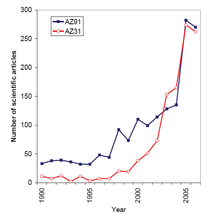- Magnesium alloy
-
Magnesium alloys are mixtures of magnesium with other metals (called an alloy), often aluminium, zinc, manganese, silicon, copper, rare earths and zirconium. Magnesium is the lightest structural metal. Magnesium alloys have a hexagonal lattice structure, which affects the fundamental properties of these alloys. Plastic deformation of the hexagonal lattice is more complicated than in cubic latticed metals like aluminum, copper and steel. Therefore magnesium alloys are typically used as cast alloys, but research of wrought alloys has been more extensive since 2003. Cast magnesium alloys are used for many components of modern cars, and magnesium block engines have been used in some high-performance vehicles; die-cast magnesium is also used for camera bodies and components in lenses.
Magnox (alloy), whose name is an abbreviation for 'magnesium non-oxidising', is 99% magnesium and 1% aluminium, and used in the cladding of fuel rods in some nuclear power stations.
Magnesium alloys tend to be referred to by short codes (defined in ASTM 275) denoting the approximate chemical composition by weight: for example, AS41 has 4% aluminium and 1% silicon; AZ81 is 7.5% aluminium and 0.7% zinc. If aluminium is present, manganese is almost always also there at about 0.2% by weight to improve grain structure; if aluminium and manganese are absent, zirconium is usually present at about 0.8% for the same purpose.
Contents
Designation
Magnesium alloys names are often given by two letters following by two numbers. Letters tells main alloying elements (A = aluminum, Z = zinc, M = manganese, S = silicon). Numbers tells nominal compositions of main alloying elements respectively. Marking AZ91 mean magnesium alloy where is roughly 9 weight percent aluminum and 1 weight percent zinc. Exact composition should be confirmed from the standards.
Cast alloys
Magnesium casting proof stress is typically 75-200 MPa, tensile strength 135-285 MPa and elongation 2-10%. Typical density is 1800 kg/m3 and Young's modulus is 42 GPa.[1] Most common cast alloys are:
- AZ63
- AZ81
- AZ91
- AM50
- ZK51
- ZK61
- ZE41
- ZC63
- HK31
- HZ32
- QE22
- QH21
- WE54
- WE43
- Elektron 21
Wrought alloys
Magnesium wrought alloy proof stress is typically 160-240 MPa, tensile strength is 180-440 MPa and elongation is 7-40%. The most common wrought alloys are:
- AZ31
- AZ61
- AZ80
- Elektron 675
- ZK60
- M1A
- HK31
- HM21
- ZE41
- ZC71
Wrought magnesium alloys have a special feature. Their compressive proof strength is smaller than tensile proof strength. After forming, wrought magnesium alloys have a stringy texture in the deformation direction, which increases the tensile proof strength. In compression the proof strength is smaller because of twinning, which happens more easily in compression than in tension in magnesium alloys because of the hexagonal lattice structure.
Named alloys
Aluminium alloys with magnesium
(codes: A=Aluminium C=Copper E=Rare earths, usually provided by adding mischmetal to the melt, H=Thorium K=Zirconium L=Lithium M=Manganese O=Silver S=Silicon T=Tin W=Yttrium Z=Zinc)
The thorium-containing alloys tend not to be used since a thorium content of more than 2% means a component has to be handled as a radioactive material.
Magnesium alloys are used for both cast and forged components, with the aluminum-containing alloys usually used for casting and the zirconium-containing ones for forgings; the zirconium-based alloys can be used at higher temperatures and are popular in aerospace. Magnesium+yttrium+rare-earth+zirconium alloys such as WE54 and WE43 (the latter with composition Mg 93.6%, Y 4%, Nd 2.25%, 0.15% Zr) can operate without creep at up to 300C and are reasonably corrosion-resistant.
Further alloy development
Scandium and gadolinium have been tried as alloying elements; an alloy with 1% manganese, 0.3% scandium and 5% gadolinium offers almost perfect creep resistance at 350C.[2] The physical composition of these multi-component alloys is complicated, with plates of intermetallic compounds such as Mn2Sc forming. Erbium has also been considered as an additive.[3]
Magnesium-lithium alloys
Adding 10% of lithium to magnesium produces an alloy which can be used as an improved anode in batteries with a manganese-dioxide cathode.[4] Magnesium-lithium alloys are generally soft and ductile, and the density of 1.4 is appealing for space applications.
References
- ^ Material Properties Data: Cast Magnesium
- ^ http://books.google.co.uk/books?id=uuQA1cdh78AC&pg=PA96&lpg=PA96&dq=magnesium+yttrium&source=bl&ots=JBwx3Ha5pi&sig=kkAuwaVs69FeohUYyMnp4428J3o&hl=en&ei=QOr2SvDFC9Ot4Qa_lfXcAw&sa=X&oi=book_result&ct=result&resnum=10&ved=0CB0Q6AEwCTgK#v=onepage&q=magnesium yttrium&f=false
- ^ http://www.faqs.org/patents/app/20090175754
- ^ http://www.freepatentsonline.com/4233376.html
Categories:- Magnesium alloys
- Alloys
- Magnesium
Wikimedia Foundation. 2010.

